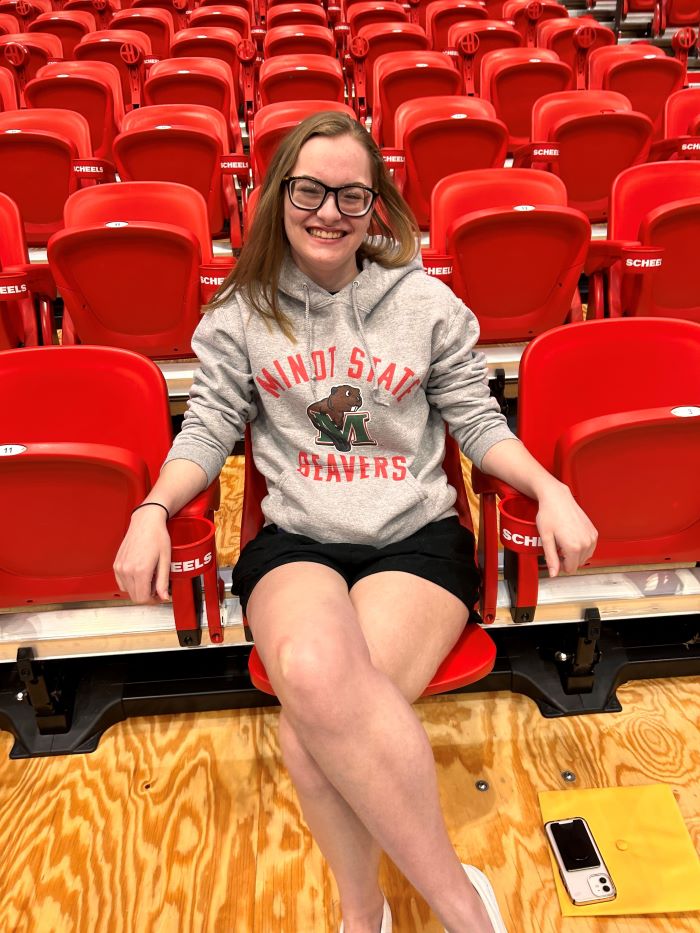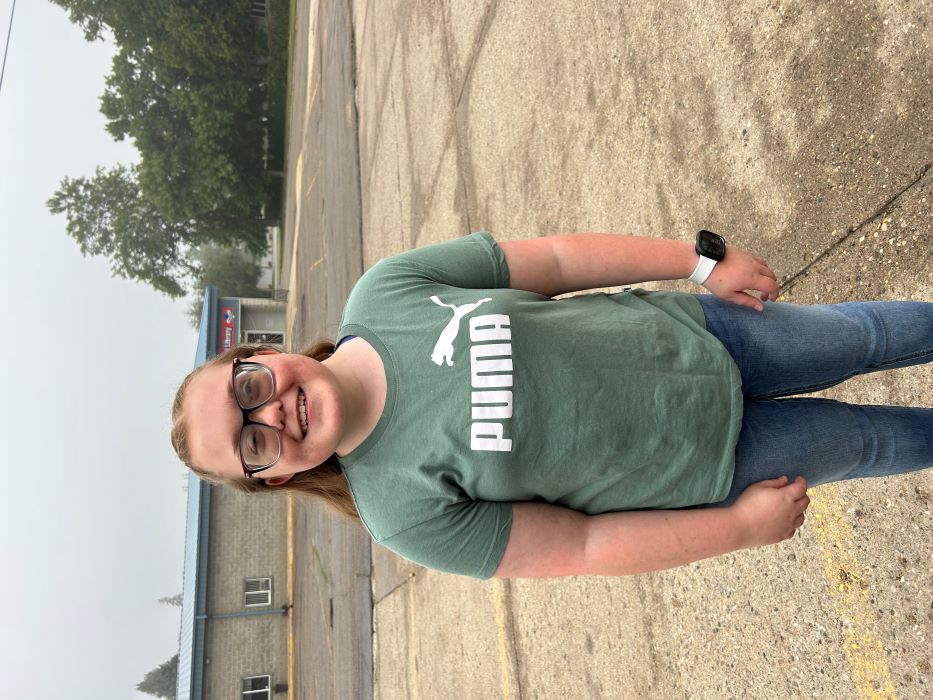
 Kaylyn, a 19-year-old freshman at Minot State University, and Ryder, a 15-year-old 9th grader from Carrington, have never met in person, but over the last nine months, they have shared their hopes and dreams with each other, as well as their struggles and frustrations. Once a week since June 2023, these two girls have talked to each other about friendship, their families, goals, self-esteem, and what it’s like to be a teenager. They’ve given each other advice, made each other laugh, and become good friends. What brought these two teenagers together? Their disabilities – both girls have a visual impairment and are deaf/hard of hearing – and the suggestion from NDVS/SB Vision Rehabilitation Specialist Amy Osvold that the two would find a lot to talk about.
Kaylyn, a 19-year-old freshman at Minot State University, and Ryder, a 15-year-old 9th grader from Carrington, have never met in person, but over the last nine months, they have shared their hopes and dreams with each other, as well as their struggles and frustrations. Once a week since June 2023, these two girls have talked to each other about friendship, their families, goals, self-esteem, and what it’s like to be a teenager. They’ve given each other advice, made each other laugh, and become good friends. What brought these two teenagers together? Their disabilities – both girls have a visual impairment and are deaf/hard of hearing – and the suggestion from NDVS/SB Vision Rehabilitation Specialist Amy Osvold that the two would find a lot to talk about.
Amy, who also has a master’s in social work, had the idea to start a mentorship program after middle school students asked her to sign a petition during their week-long program at NDVS/SB. Their petition, it turned out, was that they wanted to have more program weeks with the high school students. “They liked that example,” Amy explains. There is always one program week in the spring that both middle and high school students attend, but when Amy learned how much the students themselves appreciated that time together, she decided that she could connect students even when they’re not at NDVS/SB, in a safe place, and on their own schedule. “I think it’s really important that students with vision loss know someone else with vision loss who is in that next life stage so that they can talk about what to expect, kind of the good, the bad, and the ugly,” Amy explains.
Amy had been meeting with Kaylyn and Ryder individually, but she soon realized that these girls had connections and shared experiences that they could talk about together. “Everyone has different vision loss and different life experiences, and if you add in additional disabilities, the number of people who have those shared experiences becomes smaller and smaller,” Amy explains. While the girls have different diagnoses (Kaylyn’s visual impairment and hearing loss are from Retinopathy of Prematurity, while Ryder’s is from CHARGE Syndrome), they both know what it is like to go through life with these disabilities. Amy, who is also visually impaired, understands the impact of someone with shared life experiences can have on the other. “One of the things that was hard for me growing up was I lost my vision at the age of 5 and literally did not know another visually impaired person until I was 18,” Amy explains. “I think there were a lot of questions that could have been answered had I known somebody earlier. I remember going to college and being petrified. Knowing someone else with vision loss can help with that fear of trying something new.”
Both girls embarked on new experiences this past fall. Kaylyn started college and Ryder entered high school. While these are normal life experiences, Amy notes that they “are more complicated because of vision loss.” By talking with each other, Kaylyn and Ryder have been able to help each other out. “I think Ryder has been able to see a path with somebody who’s going to college, living on campus, and all the things that go with that new independence. And with Kaylyn, I really think it’s helped her build self-confidence by being that example for someone younger than her,” Amy says.
These mentorship sessions all take place over the phone, which means Kaylyn and Ryder have yet to meet in person. “We hope to have them meet in person sometime, but it hasn’t happened yet,” Amy says. In the meantime, Kaylyn and Ryder will continue their weekly phone calls. “The plan is as long as they are still learning and growing and wanting to meet, then we’ll meet,” Amy says. “When one of them decides they don’t want to meet anymore, we’ll stop. And if one of them still wants a mentor or to mentee, then I’ll find someone else to match them with.”
For now, Kaylyn and Ryder are happy to continue getting to know each other and learning from each other. “It’s a good learning experience,” Ryder says. “A lot of people are scared because they have a disability, but because of this, it shows you that other people have issues, too, and that you can talk to someone else about it. It picks you up from the ground.”
Kaylyn agrees, “You get to learn how other people deal with their lives and their disability, whatever that is. You get to gain some wisdom.”
Now that Amy has witnessed how Kaylyn and Ryder have helped each other, she’s hoping to expand the program to other students and to other age groups. “One of the hardest things as a rehab professional that I see is when people have lost hope,” Amy says. “It’s really hard to get that back and rebuild that self-esteem. But if we can help by showing examples of people who are in different areas of their life, we can help bridge that hope.”
If you are interested in learning more about the mentorship program or having your child or student participate, contact Amy Osvold at abrunner@nd.gov or 701-857-7635.
